|
Bay CrossingsNews
CAN THE BAY AREA PROVIDE THE SHIPBUILDING
AND REPAIR SERVICES NEEDED FOR A REGIONAL FERRY SYSTEM?
By Wes Starratt, P.E.
 |
| The Bay Ship and Yacht
Company facility in Alameda with downtown Oakland in the background |
San Francisco Bay Area has a long and well-established tradition of shipbuilding
and ship repair. The City was founded as the major Pacific Coast port, and the
Bay Area remains in the forefront of world trade. Shipbuilding and ship repair
went hand-in-hand with the regionís function as a port.
The Gold Rush of 1849 quickened the need for Bay Area and
coastal transportation, and shipyards were established to turn out wooden sloops
and schooners to carry cargo and passengers. Naval ship repair facilities in the
Bay Area were given a high priority, and the Mare Island Navy Yard was
established for that purpose in 1854.
The need for mining machinery and heavy equipment prompted
the establishment of metalworking firms such as San Franciscoís famed Union
Iron Works. But, as the needs of the mining industry began to diminish, these
firms turned to other markets, such as steamboat engines and shipbuilding.
Wooden shipbuilding was to continue for a few more decades, largely in the
Oakland Estuary. But steel had entered the picture. The first steel ship was
launched in San Francisco in 1885 by Union Iron Works, which became the first
large modern shipyard on the Pacific Coast. The shipyard continues building and
repairing ships to this day under the name of San Francisco Drydock. .
World War I stimulated shipbuilding activity around the Bay,
with shipyards in San Francisco and along the Oakland Estuary turning out
military and cargo ships. From that time onward, Mare Island began building
large warships and heavy cruisers as well as destroyers and, in more recent
years, nuclear-powered submarines.
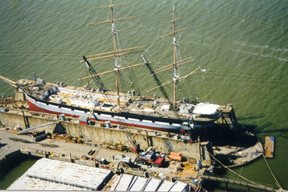 |
| Bay Ship works on a
historic sailing ship. Owner Bill Elliott got his start in the boat
building business as a wooden boat craftsperson. |
But, it took World War II, for the Bay Area to be transformed
into the largest shipbuilding center that the world had ever seen. In 1940, the
Navy purchased Hunterís Point dry docks from Bethlehem Steel Co., made it an
annex of Mare Island, and doubled its capacity with the addition of drydocks,
machine shops, and fabrication facilities. At the same time, facilities were
added and shipbuilding activities at Mare Island were dramatically increased.
In the once sleepy little town of Richmond, industrialist
Henry J. Kaiser transformed the bay shore into four shipyards employing 90,000
workers that built a total of 747 Liberty, Victory, and Naval ships on a
production-line basis. By warís end, the lights were burning round-the-clock
in Richmond as the production of ships from 27 shipways approached one every
other day.
Across the Bay, a similar transformation took place as
Sausalito became a major center of shipbuilding for the war effort. Taken
together, the Navyís Mare Island and Hunters Point yards, plus the four Kaiser
Shipyards in Richmond, the Bechtel yards in Sausalito, the Union Iron Works,
shipbuilders along the Oakland Estuary, and other yards, the Bay Area was the
center of worldwide shipbuilding during the war years.
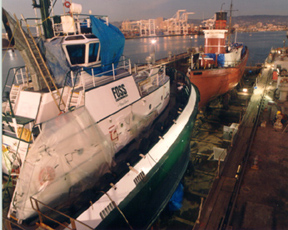 |
| Two workboats sit in
Bay Shipís drydock while undergoing repair |
The achievement was so profound that it caused Winston
Churchill to write, "Without the supply columns of Liberty ships that
endlessly plowed the seas between American and England, the war would have been
lost." A substantial number of those ships were built right here in the Bay
Area.
But the glow didnít last for long. Within a few short
years, the yards in Richmond and Sausalito were history. By 1975, the Navy
closed its Hunters Point Yard, and finally, in a frenzy to close military bases,
Ship Yard Mare Island was closed a few years ago.
Today, what is left? The Union Iron Works, now San
Francisco Dry Dock, after more than a century of activity, is still engaged in
large-scale ship repair operations, and ship repair facilities for tugs,
ferries, tour boats, and smaller vessels exist around the bay.
The Bay Area, under the pressure of World War II, transformed
itself into the center of worldwide shipbuilding. Can the Bay Area do it again
on a much smaller scale for the regional high-speed ferry fleet that is needed
to relieve the areaís transportation gridlock?
San Francisco Bayís ferry system, as it was
There was a time when the bay itself was almost the only
medium for transportation in the area, and San Francisco was at the hub. Both
transcontinental railroad lines had reached the eastern shore of the Bay: the
Southern Pacific in Oakland, and the Santa Fe in Richmond. Passengers and
freight were transferred from trains to waiting ferries for the trip across the
bay. Even railroad cars were rolled onto barges and delivered to yards in San
Francisco.
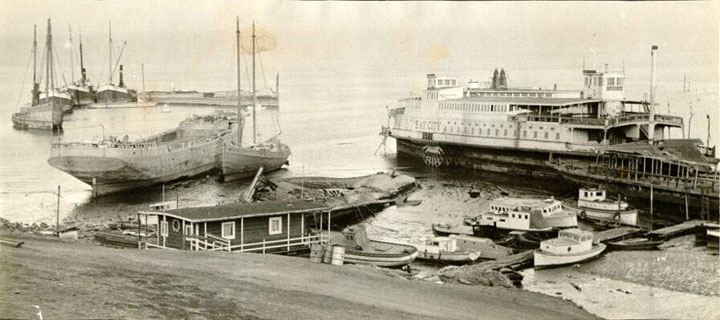 |
| Old hulks off Hunterís
Point Shipyard in 1932. Then, as now, the shipyard had fallen into
disuse. Note the ferryboat Bay City. |
If you lived in the East Bay and worked in San Francisco, you
took one of the many SP or Key Route trains and transferred to the ferries. In
Marin and Sonoma counties, you took a train to Sausalito or Tiburon to catch a
ferry for the trip to work. Literally thousands of commuters passed through San
Franciscoís Ferry Building every day on their way to and from work.
Most of the ferries carried both passengers and vehicles. For
many years, the ferry was the only way to cross the bay, or even to cross the
Carquinez Straits, or get from Richmond to San Rafael, whether you were
commuting to work, delivering goods, or taking the family for a Sunday outing.
In the 1930ís came the bridges, and soon passengers and
vehicles began leaving the ferries for the much faster trip across the bay. It
didnít take long before ferry service on the bay ceased to exist. Ferries had
become not only an endangered species, but also a species that ceased to exist.
For some 30 years, there was no regular ferry service on the bay, and freeways
crowded with automobiles completely dominated local transportation. The old
single-steel-hull ferries were indeed too slow for the pace of modern life.
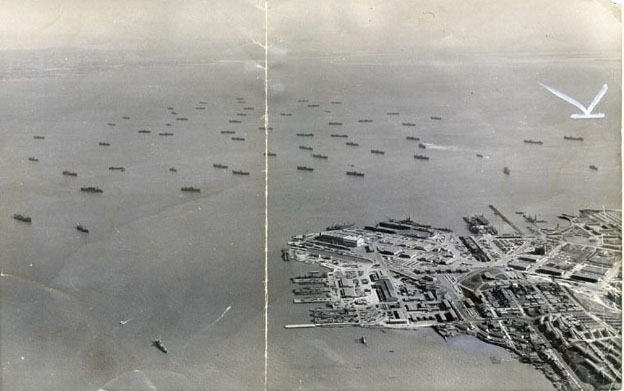 |
| Hunterís Point Naval
Shipyard in itís heyday; and aerial view taken in 1945 |
By the 1970s, the picture began to change dramatically when
ferry buffs began to realize that there was a way to attract passengers: give
them speed and comfort, and they will come!
Their persistence led to three technological breakthroughs
that completely revolutionized ferryboat design. It started when they began
asking specific questions such as,
Why not build ferries of a lighter material than heavy steel
plate?
At the same time, the aluminum industry was eying new markets
where the metalís lightweight and structural strength was a distinct
advantage, but where the difficulties encountered in welding the metal had been
a barrier. After years of effort, metallurgical engineers persisted, and
breakthrough-welding techniques were finally developed, ushering in a new
generation of ferries built of lightweight aluminum.
The second and third steps of the revolution in ferryboat
design had their roots in far off Sydney, Australia, where the locals retained a
fondness for ferries. They began asking
Why have a single-hull vessel? Why not have two or more
smaller hulls that would create less resistance as boats moved through water?
Why not use another means of propulsion than traditional
propellers? Why not water jets?
One by one, solutions were developed resulting in three
technological breakthroughs that set the stage was set for
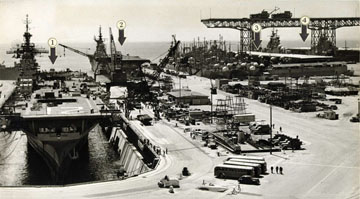 |
| Hunterís Point Naval
Shipyard in itís heyday; and aerial view taken in 1945 |
The Dawn of the Age of High-Speed Ferries
In the Bay Area, the Golden Gate Bridge District, seeing the
pressure of mounting traffic congestion on the bridge, was the first to plunge
into the new era of commuter ferry service utilizing recently developed welding
techniques for fabricating aluminum hulls. Acting on a ferry transportation plan
developed by Philip F. Spaulding and Associates of Seattle, Washington, a
unique, single aluminum-hull vessel was designed. Working with Kaiser Engineers,
a terminal site was selected at a former barge-loading facility at Larkspur
Landing, and a ferry terminal was built. By 1976, the first 725-passenger
aluminum ferry was in operation, carrying passengers on a 45-minute run to the
Ferry Building. The venture proved to be so successful that two additional
ferries of similar design were added.
Next to enter and then dominate the Bay Area ferry scene were
the catamarans. These high-speed ferries took advantage not only of lightweight
aluminum, but also twin-hull design and water-jet propulsion systems. They can
attain speeds of 36 knots, while requiring a draft of only five feet (important
in the shallow waters of the bay), and providing a fast, comfortable ride. Red
& White Fleet placed the first of the catamaran ferries, the "Catamarin,"
in service between Tiburon in Marin County and the Ferry Building in 1985. What
had been a 40-minute run was reduced to only 20 minutes, giving passengers
scarcely time to gulp their coffee. The operation proved so successful that a
second catamaran was ordered.
The dawn of the "Age of High Speed Ferry Service"
had begun, and high-speed catamaran ferries began operating to Tiburon,
Vallejo, and Alameda/Oakland, as well as for tour and excursion service. At
Larkspur Landing, Golden Gate Ferries placed its first catamaran, the "Del
Norte," in operation, reducing the run to the Ferry Building to only 30
minutes. That service proved so successful that a second vessel has been
ordered. An additional catamaran is also on order for Alameda, with further
orders expected for Vallejo and possibly Richmond and Redwood City. Because of
the appeal of the fast, comfortable service provided by the high-speed
catamarans, the Bay of San Francisco is once again becoming a transportation
corridor. The number of regular ferries of all types operating on the bay has
increased from zero to more than a dozen.
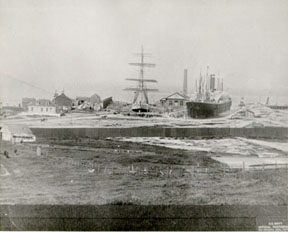 |
| Early Hunterís Point
(date unknown) |
The Metropolitan Transportation Commission foresees an
increase of only five vessels in the immediate future, but the number could
increase dramatically, if the plan for "A Bay Area High-Speed Water Transit
System for the 21st
Century" is implemented in whole or in part by the recently formed San
Francisco Bay Area Water Transit Authority. That plan calls for 28 new ferry
terminals and 75 high-speed ferries.
All of the high-speed aluminum catamarans in operation in the
Bay Area have been built on Puget Sound in the State of Washington Ö most of
them by Nichols Bros. Boat Builders in Whidbey Island, Washington, under license
from International Catamarans, Ltd. (Incat) of Australia. A second firm, Dakota
Creek Industries of Anacortes, Washington, is building catamarans under license
from Advanced Multi-Hull Designs also of Australia.
In the Bay Area, the maintenance and repair of these ferries
is being done by local shipyards, with Golden Gate Ferries able to handle all
but major maintenance requiring dry docking.
As the number of aluminum catamarans operating in the Bay
Area increases, questions arise:
First, can these vessels be maintained and serviced by
existing local facilities, in view of the stringent requirements for aluminum
fabrication?
Secondly, can these vessels be built right here in the Bay
Area?
Specialized fabrication techniques
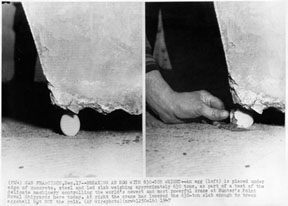 |
| Showing off the Navyís
630 ton crane, the worldís biggest: the caption boasts that, such is
the finesse of the crane, the operator is able to break the eggshell Ė
but not the yolk. |
It must be emphasized that a key factor in the building,
maintenance, and repair of these vessels is that they are made of aluminum.
Welding must be done in a dedicated covered environment, out of the wind and out
of the rain, uncontaminated by steel fabrication, and free of dust and moisture.
Welders must be specially trained and certified by the US Coast Guard. In Puget
Sound, the shipyards of both Nichols Bros. and Dakota Creek have been especially
designed for aluminum fabrication.
Ship Repair
In the Bay Area, almost all of the drydocking and major
repairs to aluminum-hulled ferries, including those of Golden Gate, Blue &
Gold, and Red & White fleets, has been done by Bay Ship & Yacht
in Alameda. The firm has trained and certified aluminum welders, developed an
expertise in aluminum fabrication, and established the necessary specialized
repair facilities. With these capabilities, the firm appears to have been the
only one bidding on the repair work and drydocking of the catamarans. Pacific
Maritime magazine, in its annual shipbuilding issue, lists Bay Ship &
Yacht with one drydock having a lift capacity of 2,800 tons, two outfitting
docks on the Oakland Estuary, two fabrication buildings and other shops. The
firm has recently added a second drydock of smaller capacity.
San Francisco Drydock has the capability of doing drydock
repairs for the new ferries, but may not be prepared to develop the necessary
expertise and dedicated facilities for aluminum fabrication. As the largest
active shipyard in the Bay Area, the firm is listed by Pacific Maritime
magazine as having two drydocks each with a lifting capacity of 60,000 tons, a
floating crane, craft shops and fabrication buildings, plus a recently acquired
dock from the Navy. Some other shipyards, including Nautical Engineering in
Oakland, are capable of providing ship repair services. Few offer expertise in
aluminum fabrication, but that expertise could be developed.
Shipbuilding
 |
| The waning days of World
War II: look at all the ships waiting off Hunterís Point. |
San Francisco Drydock is currently focused on servicing
larger cargo, cruise, and Navy ships, but the yard is capable of building any
type of ship or ferry.
Bay Ship & Yacht has already taken the first step toward
developing the facilities necessary for building catamarans. At the former
Alameda Naval Air Station, the firm has leased several bays of the former
Corrosion Control Facility, which features advanced environmental controls and
is large enough to handle a Boeing 737. Adjacent are former seaplane launching
ramps. Together these facilities could provide the closed environment necessary
for building aluminum ferries. In addition, Bay Ship & Yacht has a license
from a third Australian firm to build catamarans.
Former Naval Shipyards at Hunters Point in San Francisco and
especially Mare Island in Vallejo offer facilities that could be utilized for
building high-speed ferries. Unfortunately, each of them has problems.
Hunters Point was closed in 1975, and very little has been
maintained since then. According to a representative of the US Navy,
"Berthing is in bad shape, and buildings are in bad shape. There are three
drydocks at Hunters Point: two of them have not been maintained for more than 15
years. It would take $3 to $4 million to restore them, including the missing
caissons for closing the docks. The third drydock is leased to Astoria Metals
Corp, which has a ship breaking contract with the Navy." So, there is only
an "outside potential" for utilizing this former shipyard.
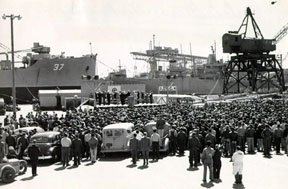 |
| Crowds of workers
gather for an announcement at Hunterís Point, a poignant reminder of
what once was. |
Mare Island offers a far greater potential. Facilities
include four drydocks measuring up to 675 ft in length, 88 ft wide, and 35 ft
deep, 13 berths up to 600 feet in length, five piers up to 725 feet in length,
three shipways, and numerous buildings that could be used for fabricating ships.
These facilities are actively being leased by Lennar Mare Island, LLC.
According to one of the shipbuilders from Puget Sound,
"Mare Island would be the logical place to start looking for a shipbuilding
facility in the Bay Area, but it has problems, since it was a steel fabrication
facility, and aluminum fabrication can not be contaminated by steel from a
previous operation." According another Puget Sound shipbuilder, "Our
first choice for a shipyard in the Bay Area would be Mare Island."
Fortunately, the base has been closed for only a few years so
most facilities are in relatively good shape. The cranes are still working, but
pump houses may need upgrading. Probably the major problem is dredging, since
none has been done since the base was closed a few years ago. There is heavy
siltation in the estuary, and gates to the graving docks are blocked by at least
15 feet of silt.
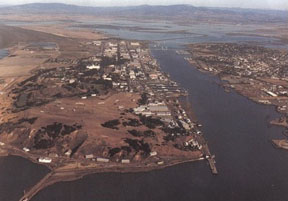 |
| Mare Island and
vicinity from the air. |
Former Kaiser Shipyard No. 3 at Richmond might also serve as
a site for a shipyard to build catamarans. It has two deep-water finger piers,
and five deep-water graving docks, the largest being 750 ft long, 100 ft wide,
and 30 ft deep. Two of the graving docks have gates and the others would require
a caisson for closure. There is a nearby concrete structure dating from the
1940s that possibly could serve as a fabricating shop, but probably such a
facility would have to be built.
Who Would Operate a "New" Shipyard for Building the
Bay Areaís Catamarans? Bay Ship & Yacht undoubtedly would have an interest
in expanding its shipyard and acquiring additional facilities. As for the two
catamaran shipyards in Puget Sound: One responded, "Our firm would
have no problem establishing a facility to build and maintain catamarans in the
Bay Area if there is the business." The other was less interested, citing
high labor and housing costs.
To answer the basic questions posed earlier in this article.
 |
| Mare Island drydocks,
thought to be the best bet for a renewed shipbuilding on the Bay. Their
future is uncertain. |
1. Ship repair facilities are adequate for maintaining the
current fleet of dozen or more ferries, but would need to be expanded to meet
the further needs.
2. Shipbuilding capabilities could be developed to meet the
needs of an expanded regional ferry system by utilizing facilities at San
Francisco Drydock, facilities leased to Bay Ship & Yacht at the former
Alameda Naval Air Station, and rehabilitating facilities at the former Mare
Island Naval Shipyard and Kaiserís Shipyard No. 3 in Richmond.
Yes, we can build and maintain our ferry fleet right in the Bay Area! |